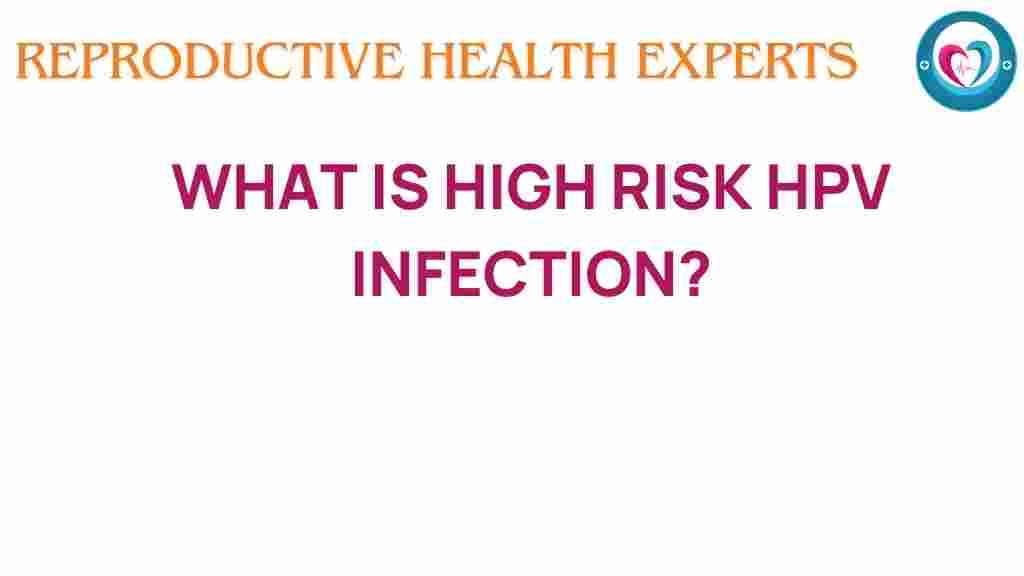Unraveling the Mystery of High-Risk HPV Infection
Human Papillomavirus (HPV) is a term that encompasses a group of more than 200 related viruses, some of which are classified as high-risk because they can lead to severe health issues, including cervical cancer. Understanding high-risk HPV is crucial for women’s health and awareness. In this article, we will explore what high-risk HPV infection is, its health risks, prevention methods, available vaccines, and the importance of screening. By the end, you will have a comprehensive understanding of high-risk HPV and how to protect yourself.
What is High-Risk HPV?
High-risk HPV refers to specific types of HPV that are associated with the development of cancer. The most notable among these is HPV type 16 and HPV type 18, which are responsible for the majority of cervical cancer cases worldwide. Unlike low-risk HPV types, which may cause benign conditions like warts, high-risk HPV can lead to more serious health complications.
Understanding HPV Infection
Most sexually active individuals will contract some form of HPV at some point in their lives. In most cases, the immune system clears the infection without intervention. However, persistent infection with high-risk HPV types can lead to precancerous lesions and eventually cervical cancer if left untreated.
Health Risks Associated with High-Risk HPV
High-risk HPV infections are primarily known for their link to several cancers. Here are the key health risks:
- Cervical Cancer: The most common cancer associated with high-risk HPV, accounting for over 90% of cervical cancer cases.
- Other Cancers: High-risk HPV is also linked to cancers of the anus, vulva, vagina, penis, mouth, and throat.
- Precancerous Lesions: High-risk HPV can cause changes in cervical cells, leading to precancerous lesions that may develop into cancer over time.
Prevention of High-Risk HPV Infection
Preventing high-risk HPV infection is essential for reducing the risk of associated health issues. Here are several effective prevention methods:
- Vaccination: The HPV vaccine is highly effective in preventing infections with the most common high-risk HPV types. It is recommended for preteens, but can be given up to age 45.
- Regular Screening: Pap tests and HPV tests help detect changes in cervical cells. Women should begin screening at age 21 and continue based on their healthcare provider’s recommendations.
- Safe Sexual Practices: Using condoms can lower the risk of HPV transmission, although it does not eliminate it completely.
- Limiting Number of Sexual Partners: Reducing the number of sexual partners can decrease the risk of contracting HPV.
The HPV Vaccine: A Key to Prevention
The HPV vaccine is a critical tool in preventing high-risk HPV infections. Here’s what you need to know about the vaccine:
- Types of Vaccines: There are three vaccines available: Gardasil, Gardasil 9, and Cervarix. Gardasil 9 covers the most common high-risk HPV types.
- Age Recommendations: The vaccine is recommended for preteens aged 11 to 12, but it can be administered as early as 9 years old and up to 45 years old.
- Safety: The vaccines have been proven to be safe and effective, significantly reducing the incidence of high-risk HPV infections and related cancers.
Importance of Regular Screening for Women
Regular screening is crucial for early detection of potential health risks associated with high-risk HPV. Here’s why:
- Early Detection: Screening can identify precancerous changes in cervical cells before they develop into cancer.
- Monitoring Health: Regular screenings allow healthcare providers to monitor any changes and provide necessary interventions.
- Peace of Mind: Knowing your HPV status and having regular check-ups can alleviate anxiety and ensure timely care.
Steps to Take If You Have High-Risk HPV
If you have been diagnosed with high-risk HPV, it is important to take proactive steps to manage your health:
- Consult Your Healthcare Provider: Discuss your diagnosis and any necessary follow-up care or treatment options.
- Follow Recommended Screening Guidelines: Adhere to the screening schedule advised by your healthcare provider.
- Consider the HPV Vaccine: Even if you have high-risk HPV, the vaccine may still protect against other strains.
- Maintain a Healthy Lifestyle: A balanced diet, regular exercise, and avoiding smoking can support your immune system.
Troubleshooting Tips for HPV Management
Managing high-risk HPV can be daunting, but here are some troubleshooting tips to help:
- Stay Informed: Keep yourself updated on the latest research and recommendations regarding HPV.
- Communicate Openly: Talk to your sexual partners about your HPV status and the importance of safe practices.
- Seek Support: Join support groups or forums where you can share experiences and learn from others.
Conclusion: Raising Awareness on High-Risk HPV
High-risk HPV infection remains a significant public health concern, particularly due to its association with cervical cancer and other malignancies. By understanding the health risks, prevention methods, and the importance of vaccination and screening, individuals can take charge of their health.
Awareness is key in combating the stigma surrounding HPV and empowering women to seek the necessary care. If you have more questions or need further information, consider visiting the CDC’s HPV page for comprehensive resources.
Remember, taking proactive steps today can lead to a healthier tomorrow. Don’t hesitate to reach out to your healthcare provider to discuss your HPV status and any health concerns you may have.
By spreading knowledge and implementing preventive measures, we can collectively reduce the incidence of high-risk HPV infections and improve women’s health outcomes. Stay informed, stay safe, and prioritize your health!
This article is in the category Conditions and created by ReproductiveHealthExperts Team

2 thoughts on “Unraveling the Mystery of High-Risk HPV Infection: What You Need to Know”